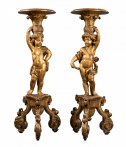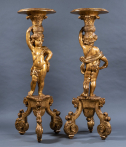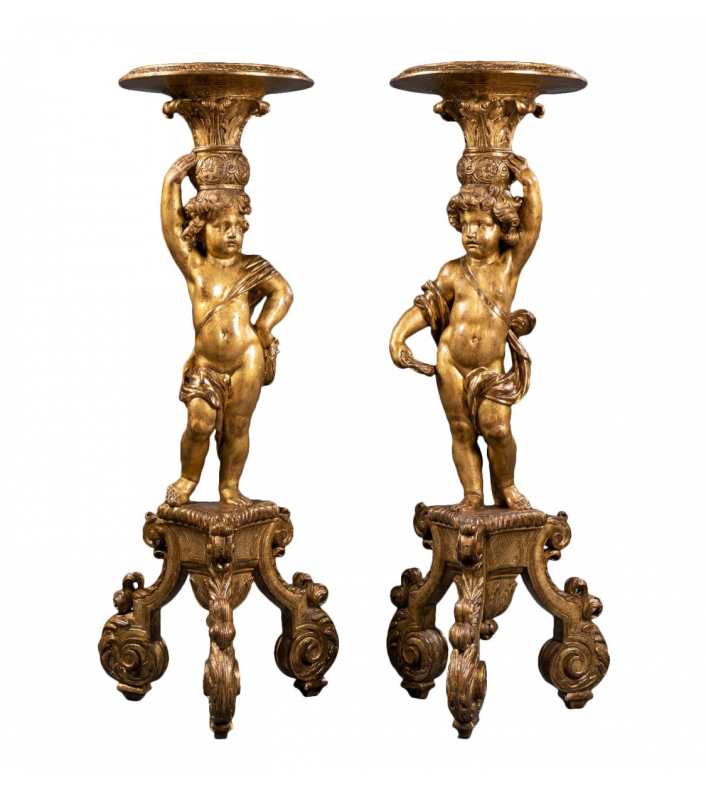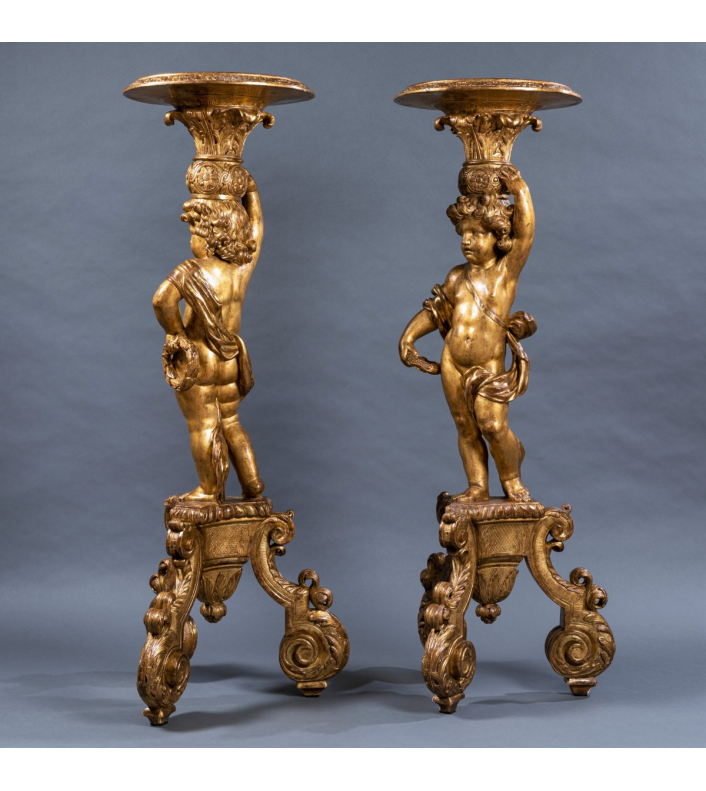The extremely rare pair of porte-torcheres we're offering is a sumptuous testimony to the virtuosity of sculptors combined with the art of "reparure" and gilt on wood under the reign of Louis XIV.
Executed around 1670, thanks to their extreme craftsmanship and their expressive force, they take a part in the exceptional production of the Louis XIV century.
They feature two young chubby and naked children, standing on a tripod base and supporting trays which are serving to place girandoles.
These pieces of furniture designed to highlight the main figure are above all the independent work of art.
The two puttis, whose turned heads are positioned to look at each other, display an admirable sway of the body. They hold the basket on their head with one arm, while with the other hand they hold laurel wreaths. An undulating veil covers their nakedness. The wrinkled fabrics are tied with ribbons around their plump bodies, passing through the shoulders and between the legs and falling to the back, twisting and accentuating their posture in contrapposto.
The faces with rounded foreheads, swollen cheeks and half-open mouths each have their own expressiveness. Their hair with large curly locks flies in the wind.
The tripod bases consist of inverted console windings, adorned with acanthus leaves and gathered around a central lamp base with vegetal decoration ending in a pine cone.
While the sculptor's work exudes great plastic strength, the extreme finesse of our pieces lies in the work of "reparure" and gilding. This admirable care given to each part of the sculpture enhances the magnificence of the whole.
By digging into the thick layer of the primer, the "repareur" like a chaser redraws strands of hair, eyebrows and pupils of our figures.
Working on the basket from which the acanthus leaves escape and the underside of the top, he creates all the veins of the foliage and reworks the surfaces left smooth by the sculptor by designing grid backgrounds.
Finally on the tripod bases, he does a remarkable job by enhancing all the leafy windings, but also by creating striated patterns following the shape of the consoles as well as a trellis around the central shaft.
The great care taken in execution, combined with a noble and harmonious design, allow our pair of porte-torchers to perfectly embody the French art and taste of the Louis XIV era.
Parisian work, attributed to the sculptor Matthieu Lespagnandelle
Around 1670.
Oak wood.
Height: 120 cm, tray diameter: 40 cm
Fine original condition, the top
Similar works in museums:
A pair of porte-torchers at Knole Hous, United Kingdom, 1671, probalby gift from Louis XIV, sculptor: Matthieu Lespagnandelle
A putto, element of porte-torchere, Musée des Arts Decoratifs, Paris, provenance unknown, sculptor: Matthieu Lespagnandelle
Pedestal table with puttis, Louvre Museum, for Château de Versailles, 1669, sculptor: Philippe Caffieri.
Historical context :
The design of our pair of porte-torcheres finds its source of inspiration in the silver pedestals of the silver furniture of Louis XIV and the designs of Charles le Brun.
For the furnishing of the Palace of Versailles, Louis XIV turned to the greatest craftsmen of his time, and of course to the director of the Manufacture des Gobelins, Charles Le Brun, who imagined the silver furniture. This series of furniture includes consoles, mirrors, porte-torcheres and the famous silver throne.
The creation of this precious furniture created similar desires among the nobles, who turned to gilt wood in an attempt to imitate the furnishings of the great king.
The porte-torcheres, intended to receive girandoles on their tops, thus become an essential piece of furniture for the riches of the kingdom.
In order to make gilt wood furniture as sumptuous as silver furniture, the work lies not only in sculpture, but also in gilding and reparure.
Repareurs, such as goldsmiths, engrave and draw in the thick coat of primer to mimic engraving and chasing on metal.
Obviously even the king cannot furnish himself entirely in silver furniture. For all the decorations of the Palace of Versailles, he called on wood sculptors, the most famous of whom and at the origin of an entire dynasty was Philippe Caffieri. This sculptor collaborates with Mathieu Lespagnandelle for various works, such as interior fittings (stairs, windows, ceiling frames) or making furniture including mirrors and scabellons. This collaboration is also repeated on several royal sites, at the Louvre, Tuileries, Trianon and St Germain. Mathieu Lespagnandelle during his carrier, also worked on the decoration of the Château de Vaux Le Vicomte, employed by Nicolas Fouquet.
It was probably on this site that he was inspired by the works of various Baroque sculptors such as Michel Anguier or the Flemish Philippe de Buysters. His incredible series of children carrying baskets is also strikingly similar to the figures of our porte-torcheres.
The extreme refinement of our pieces, the direct reflection of their owner, obviously leads us to an order of princely origin. In the absence of detailed written sources, it's difficult to suggest a potential client, whose taste, ambition and above all the means could suffice for the execution of such pieces requiring intervention of several exceptional craftsmen.

















